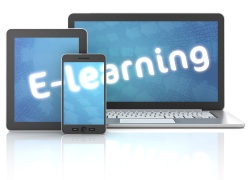
eLearning came into existence much before the internet. Initially eLearning was mainly restricted to computer based training (CBT), where the courses/tutorials were delivered to your doorstep or organization, and users could take the courses at their pace and required no internet connection. In a way, this was eLearning in the offline mode. With the penetration of internet and the advancement in network speed, eLearning moved from offline mode to its current state of on-demand interactive learning via internet A.K.A the online mode. With passage of time, eLearning became an integral part of learning as tracking of the learner’s progress was possible through technology.
Of late, this trend seems to have come full circle with need for offline eLearning rising rapidly because eLearning in online mode is able to provide an optimum level of engagement only if the learner has good internet connectivity. However, there are many scenarios where people with learning needs have no or very poor internet connectivity like travelling workforce, people stationed in remote areas, or even work places with restricted internet access due to security reasons.
In such scenarios, eLearning will only be possible in the offline mode i.e without internet connectivity. But since tracking learner’s progress is crucial, one needs a solution which will allow the learner to –
- Download / copy the course content to individual machine
- Go through the course in offline mode
- Sync back the progress to the learning management system (LMS) as and when there is internet connectivity.
Most of the current Learning Management Systems (LMS) simply cannot accommodate this need; they require ongoing secure communication to serve learning and record progress. Hence the organizations require a separate solution to achieve this goal of offline learning. An Offline Content Player helps to fulfill this need.
Let’s take a look at some of the scenarios where an Offline Player will be helpful:
Scenario 1: In Oil and Gas industry a large workforce works at far off rigs to explore and extract oil and gas. These places are mainly in the midst of a desert or in the sea, and hence with little or no internet connectivity. The workforce has time at their disposal and this time can be effectively utilized for learning new skills / information.
Scenario 2: In certain situations the organization has a widely dispersed or continuously moving workforce i.e. medical representatives, salespersons, service engineers etc.. In this situation, it is very difficult for the person to get the continuous internet connectivity
Scenario 3: There are certain establishments where internet connectivity is restricted due to the confidential and highly secret work being undertaken like government and defence establishments or R&D centers
In the above cases, if the employees have to undertake the mandatory course, they can use an offline player to download the courses on their devices (Desktop / Tablet / USB drives). Once downloaded, learners can take the course offline and sync back with the LMS once they are back in the connectivity area.
As we can see from above scenarios there is clearly a need for an offline solution. Now, let us see some of the expected features/functionalities of Offline Player:
Anytime-Anywhere-Any device:
An Offline Player must allow a user to pack and download selected SCORM content, user profile, and the current progress data associated with the user, to a device of his/her choice (Desktop, Smartphone/ Tablet/ Kiosk). To ensure that the learners can get the same experience on their mobile device, a mobile version of the offline player will be a good idea.
Users should then be able to simply unpack and play the course anywhere at their convenience without depending on internet connectivity. The player must conform to the SCORM/AICC manifest and ensures that all compliant course content is made accessible to the end user.
Enhanced User Experience:
The offline player should be able to accommodate the same look and feel of an organization’s existing LMS. This would bring familiarity to the user will therefore not require any special training to take courses with the help of offline payer and get started with the training right away.
Ability to auto-synchronize:
Offline player must be able to synchronize with the LMS after a specific time interval or upon detecting internet connectivity.
Improve ROI from your Learning efforts:
Offline Player must integrate with any existing LMS to increase the return on your existing training investments. This can help to increase the usage of existing training materials and reduce the total cost of ownership of a learning system.
Security:
Offline player should provide secured access to the course content only to the intended user, by providing appropriate authentication techniques. Furthermore, the player must ensure that the user profile, progress data and the course content itself is encrypted to uphold the security and privacy of the user and the downloaded course content.
An offline player can definitely boost the efforts of an organization and educational institution’s training and learning needs. It can help tap even the most remote and mobile learner and provide the same high level of engagement one can expect from a continuously connected eLearning environment.
Harbinger Group hosted an informative webinar on How to Increase e-learning ROI through Offline Learning. Thank you for the overwhelming response to the webinar. You can view the presentation and the webinar video here






